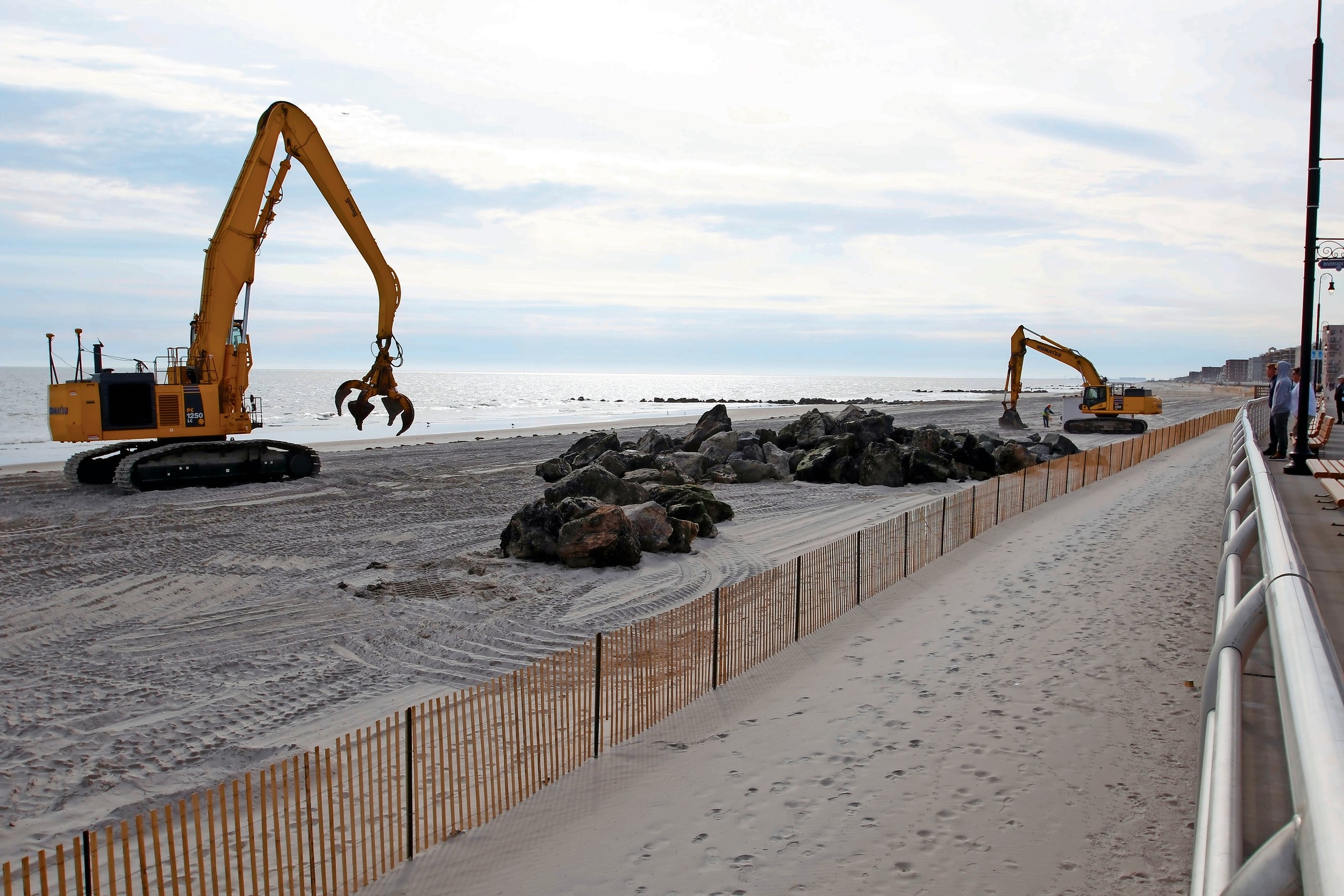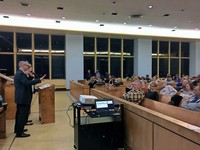Army Corps work sparks Long Beach residents’ ire
City pushes contractor to address concerns
Hundreds of people packed City Hall on April 20 to voice their concerns about an Army Corps of Engineers coastal protection project that kicked off in Long Beach last month, saying that the work has created headaches for many nearby residents.
In recent weeks, crews operating towering cranes have been hauling large stones along the beach to rebuild the jetties at Riverside and Edwards boulevards, part of a $230 million project designed to protect most of the barrier island from a 100-year storm.
Officials from the Army Corps and state Department of Environmental Conservation held a public meeting on April 20 to update residents about the project, which includes the rehabilitation of 20 jetties across the barrier island followed by the addition of roughly 4.7 million cubic yards of sand for a system of berms and dunes along 35,000 feet of shoreline.
“This project is 30 years in the making, and we’re excited it’s finally getting done and hopefully it’s going to be the protection we all need,” said City Council Vice President Anthony Eramo, adding that the city fought to expedite the project after Hurricane Sandy. “When the project is complete, Long Beach will, for the first time, have a completely engineered beach. And with that comes the responsibility of the Army Corps to maintain it should anything else happen in the future.”
Last year, the Army Corps awarded Bay Shore-based H&L Construction a $38 million contract to start work on the groins, which is expected to be completed in May 2018.
Trucks began hauling 250,000 tons of large stones through Long Beach late last summer, transporting rocks from a quarry in New Jersey; a team of 20 tractor-trailers or flatbed trucks make two trips per day Monday through Friday, between 7 a.m. and 3:30 p.m., using Park Avenue or East Broadway, and several large payloaders and other construction vehicles perform the work on the beach. There is no work on weekends or holidays.
Work on two groins, one opposite Edwards Boulevard beach and another opposite Riverside Boulevard, began in late March and is expected to be completed by May 15. Work on the next pair of jetties, located at New York Avenue and Roosevelt Boulevard, begins on May 16 and is expected to be completed on June 28.
City officials emphasized that beaches will be open this summer and that there would be no work on weekends, though certain areas near the work sites will be closed during construction. Eramo said the city convinced the Army Corps to do work on the groins at or near the staging areas, at New York Avenue and Neptune Boulevard after Memorial Day to avoid hauling rocks across the beach and reduce the impact on the busy summer season. As a result, the fencing that the Army Corps installed last month will temporarily be removed.
For safety reasons, officials urged residents and beachgoers to stay away from the rock piles and construction areas.
“By keeping the groin work close to the access points during the summer, you don’t have a haul road interfering with the beach,” John Mirando, the city’s commissioner of public works, said after the meeting.
But residents who live near the construction sites say that the work often begins before the scheduled start time of 8 a.m., and raised concerns about noise, vibrations when large stones are unloaded, idling trucks, fumes, dust and other quality-of-life issues that they maintain should have been addressed before work on such a large-scale project began.
Some residents likened the unloading of stones at 7 a.m. or earlier — some weighing as much as 15 tons — to a “mini earthquake.”
“My building shakes every single time they unload the boulders,” said one resident who lives at 25 Neptune Blvd. “The shaking is having an effect on my building — and my nerves.”
Some said that the communication between the city and Army Corps and residents was poor, and called on officials to do more to keep residents updated. Some asked whether the unloading of stones could be done “gently.”
“Asking [the contractor] to do it quietly is like asking a herd of elephants to tiptoe — it can’t be done,” said a resident of 600 Shore Rd., whose terrace overlooks the work. “Why can’t the afternoon truck bring extra stones in anticipation of the morning work so the morning truck doesn’t have to get there at 7 a.m.? There has to be a way to work this out.”
Officials said that afternoon deliveries for the next day was not practical due to the multiple trips drivers make to and from New Jersey as well as quarry hours.
Dan Falt, a project manager with the Army Corps, acknowledged that the unloading of stones is “really loud,” and said that the agency would work to address residents’ concerns.
“We can look at our work order and see what we can do to abate noise and make it more bearable,” Falt said.
Others asked why the work was being performed at the height of the summer season, and whether it would affect beach events.
Work in Long Beach began six-months ahead of schedule; work on jetties in Point Lookout last August, but Army Corps officials said that they are prohibited from working there over the summer to comply with the Endangered Species Act, mainly to ensure that piping plovers — sparrow-sized birds that nest in the project area — are protected.
City officials said that the summer concert series and other events would not be impacted. Mirando said the city is also working with the contractor to determine whether the beaches could be accessible at New York Avenue and Neptune Boulevard staging areas over the summer. Mark Evangelista, the owner of Overlook on the Beach at New York Avenue, has said that the work area and closure there was hurting his business.
Agency and city officials said that they have been pushing the contractor to abide by the work schedule and address residents’ concerns. They also said that Long Beach police would step up enforcement, and encouraged residents to report complaints.
“We’re having issues getting the contractor under control,” Mirando said at the meeting. “Once they start getting tickets, they’re going to wake up.”
“The biggest issue we were having was the trucks coming early, and instead of staying in the commercial areas, they’ve been coming into the residential areas and idling for a few hours,” Mirando told the Herald last week. “[The contractor was] very receptive to residents’ concerns, and already applied for a permit to use fire hydrants to keep the dust down — they’ll wet down the areas before the dust comes up — and order additional vibration monitoring.”

 56.0°,
Overcast
56.0°,
Overcast 







